Santa Cruz: Charles Darwin Research Station

We spent the night anchored in Academy Bay, just off of Puerto Ayora, the
largest city in the Galápagos Islands, with a population of seventeen
thousand. Puerto Ayora is home to both Renato and Javier, and I'm sure
they were both eager to see their familes. The morning was cloudy, with
more of that "misting" going on. We're pretty much damp when we come ashore.
A small, endemic bus is waiting for us, and we all have to duck and squeeze
in to board it. After that, we head off to the Charles Darwin Research
Station to see the giant tortoises.
|
The Galápagos Islands got its name from the Spanish word for tortoise.
Once estimated to populate the islands in numbers as high as three hundred
thousand, these tortoises have been driving close to extinction by man.
Over two hundred thousand tortoises have been recorded in ship logbooks
to have been taken from the island. Starting back in the whaling era,
these creatures were used for food and oil. Weighing up to 500 pounds,
they were a convenient source of fresh meat because they could live
for up to a year without food or water, and certainly easy to capture.
They would even be kept alive, as their limbs were severed one by one.
|
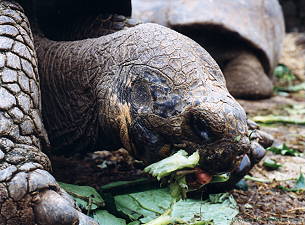
|
Even after the practice of eating the tortoises had stopped, these gentle
giants' homes have been ravaged by feral animals. Introduced animals
like dogs and cats will feed on nests and young tortoises. Goats,
burros and cattle feed on the same vegetation. That quarter of million
population mark has collapsed to about fifteen thousand.
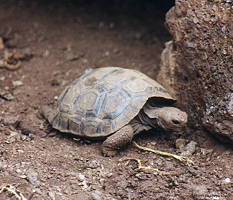
One year old tortoise
|
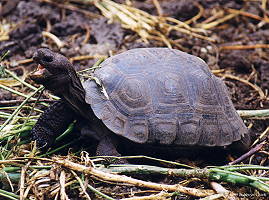
Four year old tortoise
|
One of the major efforts at the Charles Darwin Research Station is the
preservation of the eleven subspecies that remain out of the original
fourteen. Tortoises are mated, and raised in captivity, and repatriated
to the islands once they're large enough. Meanwhile, introduced animals
are being eliminated on the islands.
|
In one case, fourteen tortoises, twelve females and two males,
had been found on Española Island, and brought together to mate.
The result was just like a high school dance; the females went one way,
the males went the other. This went on for months, and researchers
were getting frustrated. Someone remembered that the San Diego Zoo
had a male from the species who had successfully mated in the past.
A phone call later, and Diegito, the Californian Stud, was on his
way to the Galápagos. The fifteen tortoises were brought together,
and this time...the females went one way, and the two males went
the other. But not Diegito, he headed straight for the nearest female
and started mating. The other males heard his sighs of rapture, and
turned to see what was going on. They finally figured it out, and
since then around 400 tortoises have been repatriated to Española.
|

|
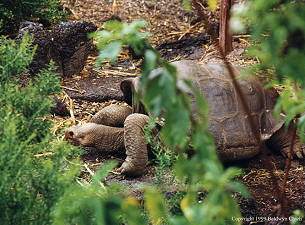
Lonesome George
|
The most famous resident of the Station, is Lonesome George. From Pinta
Island, Lonesome George is the last living individual of his species.
In an effort to preserve some of his genetic code, the females of
another species that is closest to his have been placed with him, hoping
that he'll mate. Unfortunately, he wants nothing to do with them.
Unresponsive to get-togethers, like the one Diegito attended, perhaps
the mating demonstration still needs to be of the same species.
The Research Station has decided to try to artificially inseminate
one of the female tortoises with his sperm. Renato mentioned that
one of the female naturalist guides was not finding enough work, so she
began working at the Research Station. One of her tasks was to collect
sperm from Lonesome George, which she handily succeeded in. After that,
she had very little trouble finding work as a guide.
|
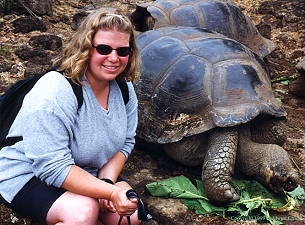
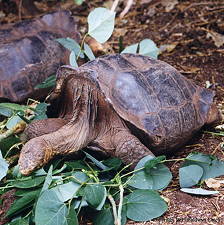
|
We were able to really meet these tortoises up close, since we were
visiting on one of their feeding days (Monday, Wednesday, and Friday).
They are indeed impressive, mammoth creatures. It is interesting to
note that in a place void of any large mammals that the tortoise would
fill in for them. The saddleback tortoises have a pronounced hump at
the front of their shells, allowing them to be the Islands' "reacher",
what deer, giraffes or other mammals would be elsewhere. They have
evolved, so that they can raise their heads high to eat from the
lower branches of cacti and other vegetation. With a competing animal,
like the introduced goat is now, the tortoises would not have evolved to
take this role.
|
Previous |
Next |
Home




